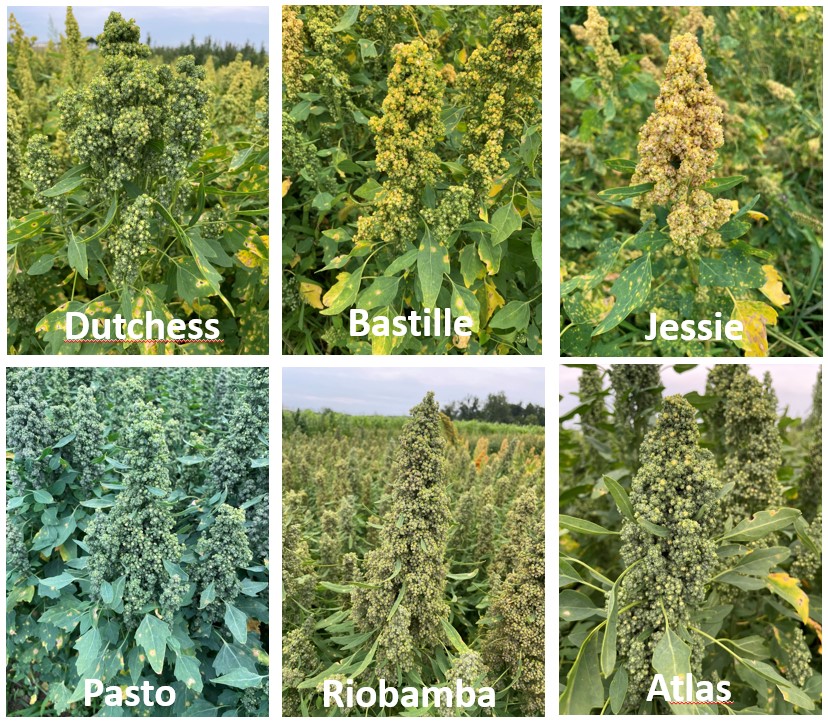Bastille
| Denomination: | 'Bastille' |
|---|---|
| Botanical Name: | Chenopodium quinoa |
| Applicant/Holder: |
Stichting Wageningen Research - Wageningen Plant Research Droevendaalsesteeg 1 Wageningen 6708 PB Netherlands |
| Breeder: |
Abbottagra S.A.R.L., Longué-Jumelles, France |
| Agent in Canada: |
Smart & Biggar LP P.O. Box 2999, Station D 55 Metcalfe Street, Suite 900 Ottawa, Ontario K1P5Y6 Canada Tel: 613-232-2486 ex. 1279 |
| Application Date: | 2021-02-25 |
| Provisional Protection:: | 2021-02-25 |
| Application Number: | 21-10443 |
Variety Description
Varieties used for comparison: 'Atlas', 'Jessie', 'Pasto', 'Riobamba' and 'Dutchess'
Summary: At 3 to 6 days after emergence, the intensity of anthocyanin colouration on the hypocotyl of 'Bastille' is weak whereas it is of medium intensity on the hypocotyl of 'Altas', 'Dutchess' and 'Jessie' and strong on the hypocotyl of 'Pasto' and 'Riobamba'. At the middle third of the main stem, 'Bastille' has stripes whereas 'Pasto' has no stripes. The leaf axil on the stem of 'Bastille' has no anthocyanin colouration whereas that of 'Pasto' has a medium intensity of anthocyanin colouration. The leaf margin of 'Bastille' has a few indentations whereas the leaf margin of 'Atlas', 'Pasto', 'Riobamba' and 'Dutchess' has a medium number of indentations. The glaucosity on the leaf of 'Bastille' is weak whereas that of 'Dutchess' and 'Pasto' have a medium degree of glaucosity. The plants of 'Bastille' flower earlier than the plants of 'Atlas', 'Pasto', 'Riobamba' and 'Dutchess'. At full flowering, the plants of 'Bastille' are shorter than those of 'Atlas', 'Dutchess' and 'Riobamba'. 'Bastille' has many female flowers per glomerule whereas 'Atlas' and 'Pasto' have a medium number and 'Riobamba' has a few female flowers per glomerule. 'Bastille' is earlier maturing than 'Atlas', 'Dutchess', 'Pasto' and 'Riobamba'. At maturity, the seed head of 'Bastille' is yellow whereas that of 'Riobamba' is orange. The seed of 'Bastille' is yellowish white whereas that of 'Atlas', 'Pasto' and 'Riobamba' is brownish yellow. The thousand seed weight of 'Bastille' is greater than that of 'Atlas', 'Jessie', 'Pasto' and 'Riobamba'.
Description:
HYPOCOTYL: weak intensity of anthocyanin colouration
COTYLEDON: anthocyanin colouration absent
PLANT: weak tendency to branch, short to medium at full flowering
STEM: green, stripes present on the middle third of main stem, anthocyanin colouration at leaf axil absent
LEAF: green, pigmentation of apex absent, widest part positioned at base, weak glaucosity
LEAF MARGIN: undulated, few indentations
PETIOLE: anthocyanin colouration absent
FLOWERING TIME: early in season
INFLORESCENCE: matures mid-season, glomerulate type, angle of panicles approximately 45 degrees, many female flowers per glomerule, bracts equal in size to utricle, seed head yellow at maturity
SEED: smooth texture of seed coat, ellipsoid shape, yellowish white, saponin content absent
Origin & Breeding History: 'Bastille' (experimental designation MEI-14-1) originated from a single plant discovered in a bulk population, of unknown parentage, on a farm in Longué-Jumelles, France in 2011. Diverse progeny from this single plant of interest was sown and bulked in 2012 and, in 2013, a single plant selection was named MEI. From fall 2013 to fall 2014, four selection cycles were done on plants grown in polytunnels. A single F6 plant designated as MEI-14-1 was selected for its' uniformity and further purified in 2015 and 2016. Selection criteria was based on seed size, grain yield, plant height, maturity time and leaf drop at maturity. Breeder seed was derived from a single F7 plant selected in 2016.
Tests & Trials: The comparative trial for 'Bastille' was conducted at the MacDonald Campus of McGill University in Sainte-Anne-de-Bellevue, Quebec in 2023. There were 3 replicates per variety arranged in an RCB design. Plots were 13.3 square metres and consisted of 14 rows with a row length of 5 metres with 0.19 metres between rows. The seeding density of 174 plants per square metre resulted in at least 2300 plants per variety. Measured characteristics were based on 30 measurements per variety except for seed weight which was based on 3 measurements per variety. Mean differences were significant at the 5% probability level based on LSD values. Results were supported by the UPOV report of Technical Examination, reference number 4061210, purchased from The Community Plant Variety Office in Angers, France. The trial was conducted by Groupe d'Étude et de contrôle des Variétés Et des Semences, France at the Testing Station in Brion, France from 2017 to 2018.
Comparison tables for 'Bastille' with reference varieties 'Atlas', 'Jessie', 'Pasto', 'Riobamba' and 'Dutchess'
Plant height at full flowering (from base to tip of inflorescence) (cm)
| 'Bastille' | 'Atlas' | 'Jessie' | 'Pasto' | 'Riobamba' | 'Dutchess' | |
|---|---|---|---|---|---|---|
| mean (LSD=10) | 99 | 145 | 102 | 97 | 123 | 121 |
| std. deviation | 8.6 | 14.9 | 6.3 | 8.7 | 8.2 | 8.7 |
Days to maturity (number of days from sowing to when 50% of the plants are dried on the upper third of the plant)
| 'Bastille' | 'Atlas' | 'Jessie' | 'Pasto' | 'Riobamba' | 'Dutchess' | |
|---|---|---|---|---|---|---|
| mean | 91 | 106 | 91 | 109 | 99 | 98 |
Thousand seed weight (grams per 1000 seeds) (g)
| 'Bastille' | 'Atlas' | 'Jessie' | 'Pasto' | 'Riobamba' | 'Dutchess' | |
|---|---|---|---|---|---|---|
| mean (LSD=0.15) | 2.88 | 2.48 | 2.63 | 2.55 | 2.33 | 2.71 |
| std. deviation | 0.11 | 0.04 | 0.07 | 0.08 | 0.01 | 0.06 |
Click on image for larger view

Quinoa: 'Bastille' (top centre) with reference varieties 'Jessie' (top right), 'Atlas' (bottom right), 'Riobamba' (bottom centre), 'Pasto' (bottom left) and 'Dutchess (top left)
Click on image for larger view

Quinoa: 'Bastille' (top centre) with reference varieties 'Jessie' (top right), 'Atlas' (bottom right), 'Riobamba' (bottom centre), 'Pasto' (bottom left) and 'Dutchess' (top left)
- Date modified: